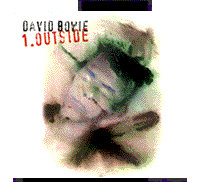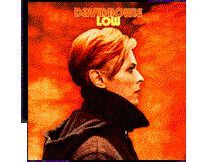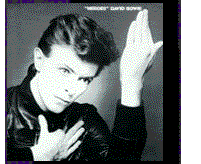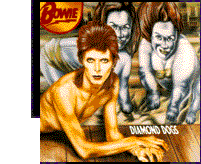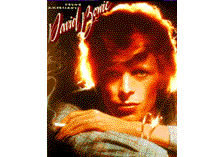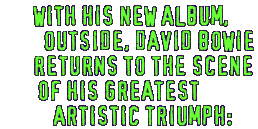
With his new album, OUTSIDE, DAVID BOWIE returns to the scene of his greatest artistic triumph: the three albums which he made with Brian Eno in the late seventies - Low, Heroes and Lodger. OUTSIDE is BOWIE's most ambitious record in fifteen years: the soundtrack for a diary not yet completed, for a film that you can replay in your own head. Each of the 14 songs can be heard individually, or as part of a multi-time, multi-viewpoint plot that veers from 1977 to the very last day of the 20th century. Just as the present always contains the past and the future, so OUTSIDE captures our current uneasiness in a format that is part narrative, part examination of moods and feelings.OUTSIDE is about what it is to be an outsider; not only where and how outsiders live, but how the fact of being an outsider makes them feel. As befits the multiphrenic nature of outsider art and emotions, BOWIE sings in any number of voices: one minute the melodramatic crooner, another the stylized Londoner, another the quiet, intimate recluse of his Berlin years. Or he is varispeeded between the album's seven characters: on one song a 14-year-old girl, on another a sleazy 78-year-old, on another a 46-year-old Tyrannical Futurist. It is only now, when he has reached his own mid life, that BOWIE can make music that can encompass the point of young, middle-aged, and old. OUTSIDE is a record that, in summarizing elements from BOWIE's many glory periods, allows him to move forward into something completely new. The music matches BOWIE's dazzling vocal/conceptual dexterity, with each collaborator providing elements of funk, rock, ambient techno, jungle and jazz-- all within the discipline of the pop song format. Although each of the 14 songs is different, they all form a complete whole: seamlessly segued, with Eno's subliminal techno- babble, into a coherent 75-minute presentation -- BOWIE's state-of-the-art travelogue through out public and private emotional confusions, at the run up to the new millennium. What you hear in OUTSIDE is turmoil; fear; a sense of time collapsing as the past thousand years whirl around our heads. As he sings at the record's climax: "It's the angel- man; I'm, deranged!" Yet there is something comforting in confronting the future: it makes you think that a future - however disturbing - is still possible. DAVID BOWIE has always worked within the future. On songs like "Hallo Spaceboy," he returns to the scene of his pivotal success: the androgynous, science fiction spaciness of his first hit, 1969's "Space Oddity." In 1980, BOWIE made his first return to this theme with the answer song, "Ashes To Ashes," by which time he had accomplished over ten years of consistent innovation, encompassing at least four different pop cultural futures -- the high-glam look of Ziggy Stardust, the soul boy funk of Young Americans, the ambient soundscapes on Low and Heroes. Somewhere during all this, DAVID BOWIE invented the pop video. Long venerated in England and Europe, it has taken BOWIE until now to reach his fullest influence in America. Nirvana's cover of "Man Who Sold The World" is forever with us on Kurt Cobain's last record. BOWIE has been cited as an inspiration by many others among the Nirvana generation: Smashing Pumpkins, Stone Temple Pilots and Nine Inch Nails, whose Trent Reznor will be collaborating with BOWIE during the next year. 1996 will also see the release of the Basquiat film (subtitled, "Build A Fort, Set It On Fire") in which BOWIE plays the character he immortalized in his 1972 song, "Andy Warhol." His co-stars are Gary Oldman, Christopher Walken and Dennis Hopper; his director, America's pre-eminent painter, Julian Schnabel. OUTSIDE takes the best of BOWIE and places him again at the forefront of popular culture, doing what he does best, singing and writing himself into the future.
|
